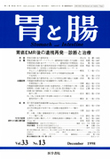Japanese
English
- 有料閲覧
- Abstract 文献概要
- 1ページ目 Look Inside
- サイト内被引用 Cited by
要旨 EMR後1年以上内視鏡的に経過観察がなされた早期胃癌178例193病巣において遺残再発病変の肉眼所見および深達度診断について検討した.①遺残再発病変は21病変(11%)にみられた.②遺残再発は非完全切除病変,非適応病変,多分割切除病変,11mm以上の病変に多かった.③遺残再発病変はEMR後,1年以上経てから起こるものが1/3を占め,これらはtub1または,sigであった.④遺残再発病変の21%は肉眼的に診断困難であり,生検の併用が必要であった.⑤粘膜断端陽性m癌の基本遺残再発形式は粘膜内再発であった.⑥遺残再発病変がsm層に及ぶ場合,診断にEUSが有用である可能性が示唆された.
We conducted this study to clarify the characteristics of cancer residue after endoscopic mucosal resection (EMR) of early gastric cancer. EMR was performed and endoscopically followed up for more than 12 months for 193 lesions in 178 patients. The results were as follows: 1) Cancer residue was seen in 21 lesions (11%). It was observed more frequently with incompletely resected lesions, partitively resected lesions, those not indicated for resection, and those more than 10 mm in diameter. 2) One third of the lesions recurred more than 12 months after EMR and some of those were difficult to detect macroscopically. Therefore, frequent follow-up is important not only during the first postoperative year but also in the subsequent years. Furthermore, biopsy of the ulcer scar after EMR should be performed in the subsequent endoscopic examination. 3) Mucosal cancer whose lateral cut margin was positive recurred in the mucosa. 4) It was suggested that EUS was effective in diagnosing small submucosal invasion of reccurent cancer.

Copyright © 1998, Igaku-Shoin Ltd. All rights reserved.


